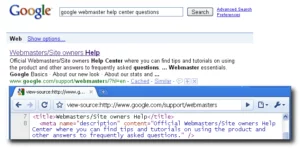Meta Data for Search Engine Optimization
Much debate has surfaced around the importance of meta data in SEO campaigns due to the rise of more sophisticated search engine algorithms and their irrelevance to overall ranking factors.
In the early days of SEO, meta data served websites as a very important ranking factor, until it became rife with keyword stuffing campaigns. Naturally, search engines had to adapt and thus we must now ask ourselves: what are the best practices for using meta data and should we even waste our time?
Essentially, meta data represents bits of data within a website’s HTML code. Within SEO, meta data is used to communicate this data to search engines for crawling and indexation purposes.
Users may be familiar with some common meta tags as the meta description and title tag are displayed within a website’s Search Engine Results Page (SERP) listing. Countless other meta tags and alt tags are hidden beneath the surface of a website’s HTML, and still serve a crucial importance in helping to index more uncommon webpage elements, such as images, videos, and headers.
You may be thinking that optimizing meta data elements is a fruitless venture. Yet, these minute chunks of information can serve as an important resource of organizing information for visitors and also in helping to increase your webpage’s CTR. Following are the five most important meta data types used in SEO ,and their importance to SEO campaigns.
- Meta Description
Meta descriptions provide a brief description of a webpage’s content within a 160-character limit. While a jaw-dropping meta description may not help your webpage rank, a keen meta description will definitely boost your search listing’s CTR. When users look over SERP listings they often consult the title tag and meta-description before making a click. A thorough meta description, with appropriate keywords, will entice users to click on your webpage listing.
Meta descriptions that don’t follow the 160-character minimum will not displayed, as they will fall under Google’s truncation policy. Be sure to optimize meta descriptions for both mobile and desktop searches; mobile character limits are only a mere 130 characters.
Meta descriptions should be apt content descriptions told in your own words. Copying and pasting the first paragraph of your article will not appear in your meta-description as search engines will be able to sniff out this tactic a mile away. Meta-descriptions should fall around 150 characters, using the appropriate keywords that are relevant to the content webpage. Keyword stuffing won’t necessarily harm your rankings, but irrelevant descriptions will result in a high bounce rate, potentially affecting your conversion rate.
- Title Tags
Title tags represent the clickable link within your search engine listing and the title of the webpage users are clicking on. Your CMS will naturally generate title-tags for snippets based on your webpage title.
Title tags are important to SEO campaigns because they persuade users to click on your website. They are the most visually appearing portion of a snippet and are the first piece of information users will see while scrolling through a SERP. Just like reading through a newspaper, the headline is the first piece of information you will consult before deciding to read further.
Title tags have a 70-character limit, though we encourage users to make title tags around 50-55 characters. Title tags should include the most relevant keywords, such as a product name or brand name at the beginning of the tag.
Title tags should flow naturally with your meta-description, and serve to compliment and describe the landing page as briefly as possible. An optimized title tag encourages social engagement, which is crucial for your social media campaign
With new advancements in search engine technology, keywords are not entirely necessary to place in keyword tags as search engines can analyze content relevance to user intent without even consulting your title tag. Keywords placed in the title tag should be thoughtful or else they’ll be viewed as spammy and effectively damage your rankings in the process. Unless you are an established brand, it might be ideal to simply make your title-tag the title of your article.
- Meta Keywords
In 2009, search engine specialists, including Google’s Matt Cutts, said that meta keywords no longer served as a ranking factor and are entirely irrelevant. But many of the world’s top companies still use meta keywords, which are hidden in a website’s HTML code—such as such as Amazon, CNN, and YouTube, which Google has owned since November 2016.
If you decide to include meta keywords in your content, they should be relevant to the content at hand. Irrelevant meta keywords do not help your website to rank for other topics and communicate distrust and spam to other websites and users.
- Meta Robots
There are four types of robots tags, “index,” “noindex,” “follow,” and “nofollow.” You only need to focus on noindex and nofollow tags, as search engines automatically index webpages and follow links without placing that tag. If you don’t want search engines to index a page (noindex) or a specific link (nofollow) than these two tags will be used. Robots tags can be used for a variety of reasons, such as not indexing duplicate content, private content, or outdated directories.
Robots tags should only be used in certainty, as misused robots tags could severely harm your SEO performance and prevent internal webpages from being indexed.
- Alternative Attributes and Miscellaneous Tags
Image tags and alternative (Alt) attributes can be used to help index images, CTA buttons, and videos on your webpage. Image alt tags are used to identify the URL of the Image itself, which could be crucial in helping to rank images for an image search. Alt attributes are used to provide a short contextual description to search engines on a variety of on-page elements, ranging from product images to decorative elements.
Best practice dictates that alt attributes should only be used on images and elements that contain relevant keywords and add SEO value to your website. While these tags will not help your webpage rank, they could be effective for communicating image descriptions to users, as well as to search engines in indexation.
Blogging websites offer users contextual tags, which can be used to classify entire taxonomies of links to search engines and users. These tags will include specific posts which link back to a specific topic tag, essentially organizing your website based on the topics you focus on. This could indirectly affect your rankings for specific webpages based on the topics they link back to.
Meta Data Conclusion
All of these elements create value for users visiting your website and help to organize your information architecture. While meta data does not act as a ranking factor for search engines, optimizing snippets for search listings has been found to increase your CTR and help communicate trust to search engines. Even if meta data does not directly affect search rankings, if it aids in SEO performance, it indirectly affects rankings to some degree.



